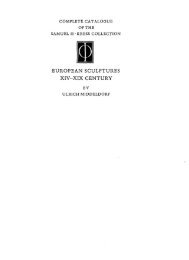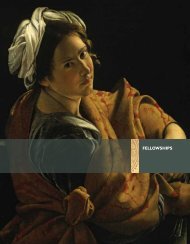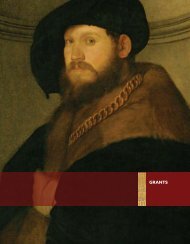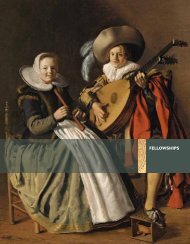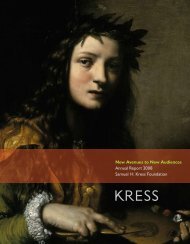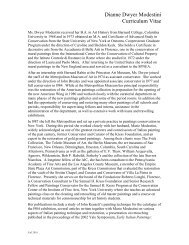The Campus Art Museum - Samuel H. Kress Foundation
The Campus Art Museum - Samuel H. Kress Foundation
The Campus Art Museum - Samuel H. Kress Foundation
Create successful ePaper yourself
Turn your PDF publications into a flip-book with our unique Google optimized e-Paper software.
Concluding Thoughts<br />
Duncan Cameron (1971/2004, 69) in <strong>The</strong> <strong>Museum</strong>: A Temple or a Forum, states that<br />
many museums cannot decide whether they want to remain a temple or become a<br />
forum for “confrontation and experimentation.” Temple and forum were not metaphors<br />
generally used by study participants. <strong>The</strong>y are useful, however, for describing how,<br />
increasingly, the perception and role of the campus art museum is changing. As a<br />
temple, the museum holds precious gems and people make pilgrimages to stand<br />
before great works of art. As a forum, the museum is a catalyst for various kinds of<br />
interactions that might be more like a laboratory or even a portal for the mixing of<br />
peoples and ideas. <strong>The</strong> thriving campus art museum is one that embraces its role as<br />
facilitator for all kinds of dialogues, research, performances, exhibits, and experiences.<br />
It welcomes diverse and interdisciplinary perspectives. It sees its role as serving a<br />
population broader than the arts community and it seeks to make a difference not<br />
only in the academic lives of students and faculty but also in their and others’ day-today<br />
lives. It also considers how the museum itself is part of the broader culture of the<br />
campus and local community and seeks to be a leader and model in local initiatives.<br />
<strong>The</strong> thriving campus art museum chooses directors with vision and energy.<br />
<strong>The</strong> director and staff work at developing positive relationships with institutional<br />
administrators, potential donors, and the wider community. <strong>The</strong>y tend to create<br />
national boards that assist through advice, connections, and donations. In return,<br />
campus administrators and legislatures understand the value of the campus art<br />
museum as a site of teaching and learning, research and scholarship, and creativity<br />
and experiences that goes well beyond valuable pictures on a wall. As museum<br />
directors across the country are quick to point out, raising funds to help support<br />
museum activities is part of their work. A balance must be reached, however,<br />
between support by the parent organization and revenue raised by the museum, so<br />
that the director and staff can put time and energy into the creative activities for<br />
which they are well-trained and positioned.<br />
This study of exemplary campus art museums suggests that it is possible<br />
for a campus art museum to be well-integrated into a college or university. <strong>The</strong><br />
kinds of things that make a difference include visionary leadership and talented<br />
staff who reach out across the disciplines; a campus-wide history and culture of<br />
supporting the arts; a campus-wide context of commitment to interdisciplinary<br />
education and research; and ability to obtain resources to carry out the museum’s<br />
vision. Similarly, in Making <strong>Museum</strong>s Matter, Stephen Weil (2002, 63) states that, “the<br />
things that make a museum good are its purpose to make a positive difference in<br />
the quality of people’s lives, its command of resources adequate to that purpose, and<br />
its possession of a leadership determined to ensure that those resources are being<br />
directed and effectively used toward that end.” Although availability of sufficient<br />
resources is problematic for several of the museums in the study, all are seeking to<br />
make a difference in the quality of people’s lives and, from the perspectives of those<br />
interviewed, are succeeding. A curator describes the work in which the museum staff<br />
and others from across the campus are engaged as one of “rethinking what a museum<br />
is, what is should be, and what it can be.” Through work like this, some campus art<br />
museums are mattering, to quote Weil (2002, 74) again, in “many marvelous ways.”<br />
Concluding Thoughts<br />
26



